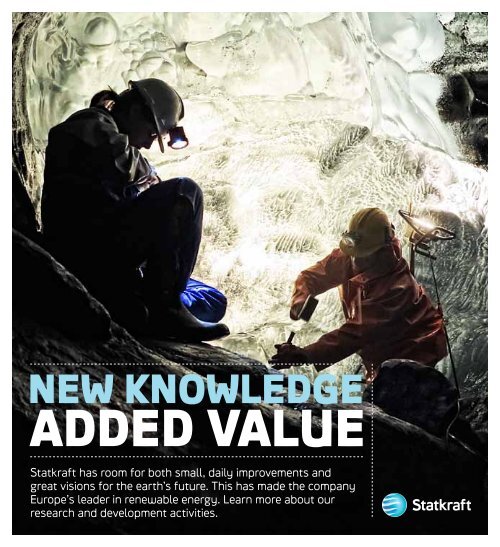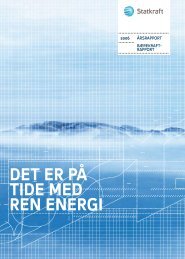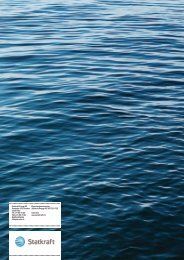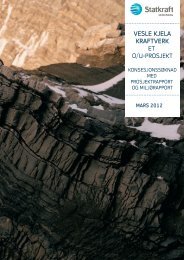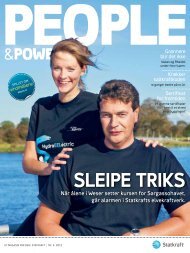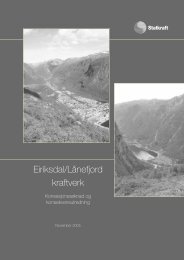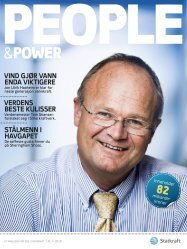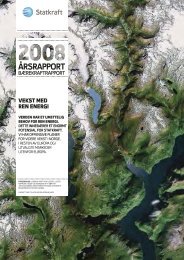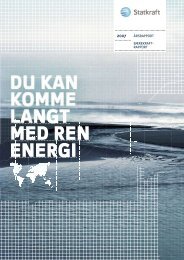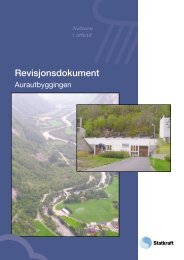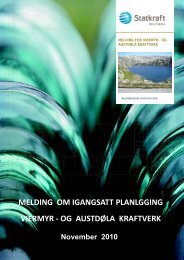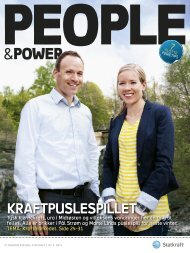added value - Statkraft
added value - Statkraft
added value - Statkraft
Create successful ePaper yourself
Turn your PDF publications into a flip-book with our unique Google optimized e-Paper software.
New knowledge<br />
<strong>added</strong> <strong>value</strong><br />
<strong>Statkraft</strong> has room for both small, daily improvements and<br />
great visions for the earth’s future. This has made the company<br />
Europe’s leader in renewable energy. Learn more about our<br />
research and development activities.
Three perspectives on R&D in <strong>Statkraft</strong><br />
Vision and reality<br />
Climate change is the most serious<br />
threat facing mankind. But despite the bleak<br />
outlook, climate change also offers opportunities<br />
for companies with tradition, resources<br />
and expertise within renewable energy. The<br />
development of renewable energy will be<br />
one of the most important tasks in the world<br />
in the time ahead, and it will be demanding,<br />
both in terms of technology and finance.<br />
<strong>Statkraft</strong> takes these challenges seriously,<br />
and therefore focuses on research and<br />
development, both in the long and short<br />
term, to meet the world’s future needs for<br />
renewable energy. Challenges regarding<br />
the environment and sustainability must be<br />
solved when new energy facilities are built.<br />
Innovation and new approaches are vital in<br />
order to find sustainable solutions.<br />
<strong>Statkraft</strong> and research communities we<br />
cooperate with, have significant knowledge<br />
about these issues. In order to solve the<br />
climate challenges, we believe in cooperation<br />
between business, industry and research<br />
institutions.<br />
Innovation is one of <strong>Statkraft</strong>’s three core<br />
<strong>value</strong>s. We want to further develop existing<br />
solutions and to implement new technologies.<br />
<strong>Statkraft</strong>’s innovation activities will<br />
contribute to increase the Group’s future<br />
competitiveness, and create results and<br />
<strong>added</strong> <strong>value</strong> for the company and society<br />
in general. There is room for both daily<br />
improvements as well as grand visions about<br />
the earth’s future in <strong>Statkraft</strong>. This has made<br />
us the largest producer of renewable energy<br />
in Europe. Here we would like to offer some<br />
examples of what we do.<br />
Christian Rynning-Tønnesen<br />
president and CEO, <strong>Statkraft</strong><br />
Without research and<br />
development <strong>Statkraft</strong> would<br />
not be Europe’s leader in<br />
renewable energy.<br />
maturity<br />
exploration<br />
Corporate<br />
R&D programs<br />
improvement<br />
<strong>Statkraft</strong>’s innovation strategy is closely aligned to our business<br />
strategy as we believe this is the key to turning R&D results and<br />
knowledge into actual innovation. We also seek to develop a balanced<br />
R&D portfolio with regards to levels of technological maturity<br />
and development lead time.<br />
Improvement projects are aimed towards continuous improvement of<br />
current operations. The purpose is to increase efficiency and further<br />
develop sustainable and environmentally friendly solutions in ongoing<br />
operations. Through the improvement projects we solve our short<br />
term challenges in existing business.<br />
Three R&D programs are established to meet the medium term need<br />
for development within specific business areas; hydropower, wind<br />
power and district heating. Through these R&D programs we develop<br />
competitive advantages and new business models to enhance future<br />
efficiency and quality in our operations. Finding environmentally<br />
friendly solutions and implementing actions to prevent unnecessary<br />
negative consequences to nature and wildlife counts for a significant<br />
part of the programs. The projects are performed in close collaboration<br />
with national and international R&D communities.<br />
Finally, our exploration activities are focused on technologies that<br />
may become important in the longer term. Promising opportunities<br />
may lead us to engage in long term development efforts and bring<br />
new sustainable solutions to the energy market.<br />
Read and learn more about:<br />
time<br />
Weather is money. Providing hydrologists with a more precise<br />
“crystal ball”.<br />
Save the salmon! Researchers look for the optimum balance<br />
between salmon and power generation.<br />
Wind energy turbines with suction. New technologies driving<br />
down costs of offshore wind farms.<br />
What will our rubbish cost? The answer will be of <strong>value</strong> to<br />
<strong>Statkraft</strong>’s district heating ventures.<br />
World leader in osmotic power. Developing the perfect membrane<br />
remains one of the key challenges.
maturity<br />
exploration<br />
Corporate<br />
R&D programs<br />
improvement<br />
time<br />
Continuous improvement of<br />
current operations, solving<br />
short term challenges in<br />
existing business<br />
Learning from your<br />
own errors is an important<br />
source of knowledge.<br />
The R&D work in <strong>Statkraft</strong> under the “Improvement”<br />
label addresses everyday issues<br />
and give quick results. In these projects we<br />
look at existing facilities, investigate faults<br />
and renovate or improve elements in the day<br />
to day operations.<br />
“Our motivation is to learn as much as possible<br />
about what is going on and to get the<br />
most out of our resources, such as increasing<br />
the effect from turbines, or to sensibly renovate<br />
a dam. It is about learning from previous<br />
errors, and introducing measures that are as<br />
inexpensive as possible, while at the same<br />
time complying with all regulatory requirements,”<br />
says Anne Marit Ruud, section head<br />
Construction.<br />
Input to Improvement projects can come<br />
from our own business areas, from research<br />
institutions, consultancy firms or from the<br />
industry organization Energy Norway.<br />
The R&D work also has an important recruitment<br />
function. “Some of our R&D funds<br />
are for example spent on professors and<br />
students at the Department of Hydraulic and<br />
Environmental Engineering and the Hydropower<br />
and water research labs at the Norwegian<br />
University of Science and Technology<br />
(NTNU. We have seen a significant increase in<br />
Master’s degree students specializing within<br />
hydropower related topics. The latter is<br />
particularly important to us, as it contributes<br />
to the recruitment of necessary expertise for<br />
the future” Ruud stresses.<br />
3D erosion estimates<br />
Some of <strong>Statkraft</strong>’s rockfill dams have<br />
had short period leaks through the core. To<br />
increase employees’ expertise for estimating<br />
the strength of the dam and the water flow<br />
force it can handle, there is an R&D project<br />
under way to develop a 3D estimate model.<br />
The model is capable of estimating both the<br />
quantity of water and the direction of the<br />
water flow through the dam. Other issues<br />
under consideration include the direction of<br />
the plastering rock in the dam. A Master’s<br />
student has been hired to carry out the R&D<br />
project, and she is using <strong>Statkraft</strong>’s Jukla<br />
dam as a case study.<br />
Hydrologists get a new<br />
“crystal ball”<br />
In order for <strong>Statkraft</strong> to optimize power<br />
production, prognoses for influx to power<br />
plants and reservoirs are an important aspect<br />
of the decision-making basis. Today hydrological<br />
models deliver influx prognoses up to ten<br />
days ahead, but carry with them a degree of<br />
uncertainty. When using hydrological models,<br />
one must take some uncertainties into consideration.<br />
One type of uncertainty relates to the<br />
observations of precipitation and temperature.<br />
Other uncertainties originate from conditions<br />
in the hydrological model, such as snow and<br />
groundwater reservoirs.<br />
Together with SINTEF, project personnel<br />
from <strong>Statkraft</strong> aim to<br />
establish a framework to<br />
describe the various<br />
sources of uncertainty<br />
and finally determine<br />
their net effect.<br />
This means that the<br />
influx prognoses can<br />
be based on probability<br />
rather than<br />
expected <strong>value</strong>s, which<br />
means they will be<br />
far more informative<br />
when projecting the<br />
power generation.<br />
Can chemistry undercover<br />
transformer faults?<br />
In order to identify the fault that caused the transformer at the<br />
Svartisen Power Station to fail in 2011, <strong>Statkraft</strong> has initiated<br />
an R&D project for chemical analyses. This incident was very<br />
costly for <strong>Statkraft</strong>, and a thorough analysis of the mechanisms<br />
that took place may therefore be very useful in the long term,<br />
both to strengthen the expertise in the company and to prevent<br />
future disruptions and similar failures. Samples are collected<br />
from the crash location in the transformer, and to identify various<br />
causal connections, the analyses are reviewed together with electric<br />
measurements from before the breakdown. The results will be<br />
used for updating requirement specifications and operational<br />
routines in order to improve future reliability in operations.<br />
51.5<br />
TWh<br />
In 2011, <strong>Statkraft</strong><br />
produced a total of<br />
51.5 TWh of energy<br />
(51.5 billion kilowatt<br />
hours). This is<br />
enough to supply<br />
more than two<br />
million homes with<br />
energy (measured<br />
by Norwegian consumption,<br />
which is<br />
the world’s highest).<br />
Of this production,<br />
91 per cent<br />
came from renewable<br />
sources, while<br />
natural gas power<br />
(mainly in Germany)<br />
contributed 8.9 per<br />
cent.<br />
Did you know ...<br />
… that <strong>Statkraft</strong> is<br />
Europe’s largest<br />
producer of renewable<br />
energy?<br />
<strong>Statkraft</strong> has a total<br />
of 3400 employees<br />
in 20 countries<br />
around the world.
hydropower<br />
maturity<br />
exploration<br />
Corporate<br />
R&D programs<br />
improvement<br />
time<br />
Three R&D programmes aim<br />
to meet the medium term<br />
needs for development within<br />
three core business areas.<br />
Did you know ...<br />
… that in 2011,<br />
<strong>Statkraft</strong> produced<br />
46 TWh of energy<br />
from its hydropower<br />
plants, equivalent<br />
to the consumption<br />
of more than 1.7<br />
million Norwegian<br />
homes?<br />
100<br />
million<br />
For the period<br />
from 2011 to 2014,<br />
<strong>Statkraft</strong> has<br />
allocated a total of<br />
NOK 100 million to<br />
its hydropower R&D<br />
programme.<br />
Best possible flow<br />
The project «Flow Control Technology» is<br />
another example of a successful partnership<br />
with suppliers. The goal for this project was<br />
to apply new technology and knowledge to<br />
minimize the negative effect of flows in the<br />
lead blades on Francis turbines. Both when<br />
the water is entering and exiting the turbine,<br />
there is a risk of wear, strain and loss of<br />
energy efficiency due to flow phenomena. In<br />
short, it is about creating the best possible<br />
flow in production.<br />
The project found solutions for some of<br />
these challenges which can be applied to<br />
both hydro and wind power.<br />
A turbine revolution<br />
Norwegian water is usually very clean, but outside of Norway, power<br />
producers often face major challenges in connection with sediment<br />
and silt in the water flow. As a result of the intense water pressure,<br />
these particles may cause severe damage in the turbines, leading to<br />
rapid wear. To cope with this problem, SN Power (where <strong>Statkraft</strong> is the<br />
majority owner) has entered a partnership with the supplier Dynavec<br />
to develop a new Pelton turbine design. In conventional turbine<br />
designs, the turbine is in one piece, making it difficult to achieve the<br />
optimum coating or surface treatment. This new design is revolutionary<br />
as it is module based, i.e. in individual sections. The advantage<br />
is that each section can be thoroughly coated before the turbine is<br />
assembled. This decreases wear and increases its life span.<br />
Another advantage of the new design is that the individual parts<br />
can be replaced without having to move the entire wheel. Thus, the<br />
facility does not have to be shut down for longer periods of time during<br />
maintenance, and downtime is greatly reduced. This is the very<br />
first solution of this kind, and a fine example of explicit technology<br />
development carried out with a supplier.<br />
Optimum conditions for salmon<br />
<strong>Statkraft</strong> is also engaged in more long term research, for example<br />
through the research centre CEDREN, one of a total of 11 research<br />
centres for environmentally friendly energy (FME) established by the<br />
Research Council of Norway. CEDREN addresses issues concerning<br />
environmental design. A basic theme is how future facilities and river<br />
systems can be designed to even further preserve the environment<br />
while maintaining power production.<br />
One example is the EnviDORR project, which has developed a new<br />
model for hydropower facilities, which optimizes the relationship between<br />
power generation and salmon, both in the current and future<br />
climate. The model becomes a tool for regulating water flow and<br />
production in a river system, so that conditions are optimal, both for<br />
the salmon and for <strong>Statkraft</strong>.<br />
We develop clean energy for the<br />
future, in interaction with the<br />
environment and society in general.<br />
How should <strong>Statkraft</strong> relate to a changing European<br />
energy market? How can the company<br />
utilise and further develop its strong hydropower<br />
position?<br />
These are just some of the questions we seek<br />
to answer through the Hydropower programme<br />
which will secure access to relevant technology,<br />
contribute to sustainable solutions, and<br />
ensure recruitment and expertise building in<br />
<strong>Statkraft</strong>.<br />
“The program has a strategy function that<br />
involves looking further and higher ahead to<br />
develop hydropower as a renewable source of<br />
energy for the future” says programme head<br />
Uta Gjertsen. One of the challenges high on the<br />
agenda are ageing hydropower facilities. Many<br />
of the facilities and components are now nearing<br />
the end of their design life time, and require<br />
rejuvenation and upgrades.<br />
“We also have many projects abroad. This is<br />
demanding for us as the developer, in terms of<br />
both technical and environmental requirements.<br />
There are other geological and topological conditions,<br />
other climate and social conditions we<br />
must take into consideration,” Uta says.<br />
Another important issue is related to the<br />
changing European energy system, with more<br />
renewable and inflexible power generation (solar<br />
and wind). “As the share of inflexible energy<br />
increases, it will impact us who produce flexible<br />
hydropower. This so-called regulating power issue<br />
is an important area of knowledge in terms<br />
of <strong>Statkraft</strong>’s future opportunities,” Uta argues.<br />
All the projects in the Hydropower programme<br />
are externally operated, meaning that<br />
they are executed in partnership with other<br />
research institutions and suppliers.
wind power<br />
maturity<br />
improvement<br />
Corporate<br />
R&D programs<br />
exploration<br />
time<br />
Three R&D programmes aim<br />
to meet the medium term<br />
needs for development within<br />
three core business areas.<br />
The development of<br />
offshore wind power requires<br />
massive research<br />
and development efforts.<br />
In order to compete in the rapidly<br />
growing offshore wind market,<br />
<strong>Statkraft</strong> has to limit the financial risk<br />
associated with investments. Cost<br />
reductions are therefore one of the<br />
main objectives in the R&D programme<br />
for competitive wind power.<br />
“Compromising on safety and the<br />
environment simultaneously is unacceptable”<br />
says Jørgen Krokstad, who<br />
heads the programme.<br />
There are greater challenges connected<br />
with establishing and operating<br />
wind farms in deep waters than<br />
onshore. Therefore around 70 per cent<br />
of the programme’s funds have been<br />
allocated to offshore wind and 30 per<br />
cent to onshore wind. In addition the<br />
programme’s diverse activities involve<br />
wind turbine technology development,<br />
operation and maintenance of wind<br />
farms, health, safety and consequences<br />
for the environment.<br />
One important ambition is to<br />
promote development of internal<br />
expertise through the R&D activities.<br />
“This is critical in order to succeed in<br />
the offshore wind market in the long<br />
term. In-house expertise is the most<br />
important aspect in terms of reducing<br />
risk associated with major investments,”<br />
Krokstad argues.<br />
Mobile wind farm control<br />
It is important for wind power producers to receive updated and<br />
exact operating data, and to be independent of the turbine suppliers.<br />
<strong>Statkraft</strong>’s wind farm programme has therefore developed a system<br />
for improved monitoring of the wind farms, called “Wind Power Management<br />
System”. The system will function as an independent basis<br />
for analysis of the wind farm and is an important element for achieving<br />
increased control of the farms. The system is currently delivered<br />
as a web application, however, a mobile app is planned for the future.<br />
Offshore wind turbines<br />
sucked in to the seabed<br />
One of the main challenges for <strong>Statkraft</strong>’s ambitions within offshore<br />
wind energy is to cut costs related to turbine installations far<br />
out to sea. Additionally, these installation efforts must take place<br />
in a way that does not harm the environment. Important progress is<br />
achieved on both fronts, in the form of a new concept for the foundations<br />
for offshore wind energy turbines.<br />
The current technology, which is being used at the Sheringham<br />
Shoal wind farm outside the UK, is based on so-called mono pillars,<br />
which are driven into the seabed. This technique generates a lot of<br />
noise, and it requires installation vessels and good weather.<br />
The new concept is being developed by Universal Foundation,<br />
where the Fred. Olsen Group is the main owner. It involves the application<br />
of the suction anchor principle, a Norwegian patent originally<br />
developed for the petroleum industry. In short, this means that the<br />
foundations are sucked in to the seabed using negative pressure.<br />
The technique does not require costly installation vessels, unlike the<br />
current solution. It is also gentler on the marine environment as it<br />
generates less noise.<br />
Doctor of offshore<br />
wind energy<br />
<strong>Statkraft</strong> is also an active participant in<br />
the two major national FME programmes<br />
Nowitech and Norcowe, in cooperation with<br />
both national and international industrial<br />
players. These programmes produce knowledge<br />
within the most important disciplines<br />
for offshore wind energy, including several<br />
PhDs. New theoretical models are being developed,<br />
as well as simulation programmes<br />
for wind generation and wind turbine construction,<br />
measuring techniques and testing<br />
stations. The aim is to raise Norwegian R&D<br />
knowledge on offshore wind energy to a top<br />
international level.<br />
Did you know ...<br />
… that <strong>Statkraft</strong>’s<br />
wind power<br />
production in 2011<br />
increased by 24 per<br />
cent to 0.8 TWh?<br />
This is enough to<br />
supply more than<br />
31 000 Norwegian<br />
homes. <strong>Statkraft</strong><br />
develops and operates<br />
wind farms in<br />
the UK, Norway and<br />
Sweden.<br />
80<br />
<strong>Statkraft</strong> has allocated<br />
NOK 80 million to its<br />
wind power R&D programme<br />
for the period<br />
from 2011 to 2014.
iomass<br />
maturity<br />
exploration<br />
Corporate<br />
R&D programs<br />
improvement<br />
time<br />
Three R&D programmes aim<br />
to meet the medium term<br />
needs for development within<br />
three core business areas.<br />
What will biomass<br />
cost in the future?<br />
<strong>Statkraft</strong>’s district heating facility is<br />
fuelled by various forms of bioenergy, including<br />
waste. Fluctuations in the demand for biomass<br />
impact prices and availability. Forecasts<br />
on how access, price and selection of various<br />
types of biofuels will develop in both long<br />
and short term are critical in order to develop<br />
competitive business models for the future.<br />
Biomass is an environmentally<br />
friendly and renewable energy<br />
source that is a natural part of<br />
<strong>Statkraft</strong>’s area of interest.<br />
440 GWh<br />
Did you know …<br />
… that in 2011,<br />
<strong>Statkraft</strong> produced<br />
440 GWh of energy<br />
based on bio fuels?<br />
This figure includes<br />
Norwegian and<br />
Swedish bio fuel<br />
facilities, and is<br />
enough to heat<br />
around 28 000<br />
houses.<br />
More environmentally friendly<br />
bio heat at Marienborg<br />
In the spring of 2011, <strong>Statkraft</strong> Varme decided that<br />
there was a need to rebuild the biofuel facility at Marienborg<br />
in Trondheim. The original goal was to reduce<br />
the risk of fire and explosions, but extensive changes<br />
were also made to increase the level of automation and<br />
to increase the facility’s flexibility to use various types<br />
of fuel. Furthermore, we wanted to ensure that the<br />
facility is efficient and does not have larger emissions<br />
when being partially run than when at full capacity. The<br />
project was carried out in cooperation with the Swedish<br />
boiler supplier KMW Energi AB. The facility has been in a<br />
test phase since 2011, and the results are excellent. Stable<br />
operations, lower emissions, high level of flexibility<br />
and good profitability are among the important milestones<br />
reached. In all, the project has provided <strong>Statkraft</strong><br />
Varme with a safer and more robust facility.<br />
Office building<br />
School<br />
hot water ∏<br />
cooled water π<br />
A lot of biomass research<br />
Heat Production Plant<br />
Residence<br />
CenBio is a multidiscipline research centre for environmentally<br />
friendly energy (FME) which looks at the entire<br />
bioenergy <strong>value</strong> chain from raw material to the traded<br />
product.<br />
One of the objectives for the centre is to develop a<br />
sustainable utilisation of biomass for the generation of<br />
electricity and heat. <strong>Statkraft</strong> is taking part in CenBio<br />
to participate in concentrated, focused and long-term<br />
research efforts at a high international level.<br />
Biomass is a renewable resource that could replace<br />
fossil fuels within heating and power generation, and<br />
in the long-term, perhaps even the transport sector.<br />
As a leading national player within development and<br />
operation of renewable heating, <strong>Statkraft</strong> is engaged<br />
in finding the best possible utilisation of biomass in the<br />
energy system, both today and in the longer term. What<br />
can be done to strengthen already established activities?<br />
How can the company make use of its specialist<br />
expertise in terms of developing new business opportunities?<br />
These are key questions in the bioenergy R&D<br />
programme.<br />
“The bioenergy programme is closely connected to<br />
our district heating activities. Our ambition is to reduce<br />
risk and increase profitability, while strengthening our<br />
ability to realize new bio-related business opportunities,”<br />
says programme head Monica Havskjold.<br />
Biomass is a commodity that can be traded both locally<br />
and globally, and to ensure the optimum access to fuel, a<br />
good understanding of the market is required, particularly<br />
in a long term perspective. The Bioenergy Programme<br />
in <strong>Statkraft</strong> will help us establish this expertise.<br />
Cost efficiency is a key term in the R&D programme.<br />
Development of new system solutions and technologies<br />
for energy conversion are prioritized areas. Projects that<br />
help improving existing equipment and solutions are often<br />
completed through a joint effort between <strong>Statkraft</strong><br />
and the supplier.<br />
“An important milestone for the programme is to contribute<br />
to reduce the ecological footprint. This involves,<br />
among other things, replacing fossil fuels with biomass<br />
as well as utilizing the fuel in an efficient manner,”<br />
Monica emphasizes.
maturity<br />
exploration<br />
Corporate<br />
R&D programs<br />
improvement<br />
Intense research is<br />
underway on new<br />
resources and<br />
new technology in<br />
a number of energy<br />
areas. <strong>Statkraft</strong><br />
is focused on<br />
solutions that will<br />
have long-term<br />
significance, and<br />
is already a world<br />
leader in osmotic<br />
power. But the<br />
company also<br />
sees opportunities<br />
in geothermal<br />
energy, new forms<br />
of energy storage<br />
and so-called smart<br />
energy technologies.<br />
time<br />
Activities focused on technologies<br />
that may become<br />
dominant in the long term.<br />
Osmotic power:<br />
Selecting<br />
the perfect<br />
membrane<br />
<strong>Statkraft</strong> is spearheading work in osmotic<br />
power, and is currently investing considerable<br />
resources in developing the right technology.<br />
Facts<br />
osmotic power<br />
<strong>Statkraft</strong> is now a world<br />
leader within the development<br />
of osmotic power – a<br />
clean and renewable energy<br />
form with a global potential of<br />
between 1600 and 1700 TWh.<br />
When freshwater meets<br />
saltwater, for instance, when<br />
a river runs into the ocean,<br />
vast amounts of energy are<br />
liberated. This energy can be<br />
utilised for power generation<br />
through osmosis.<br />
“We don’t know if we will succeed, but<br />
osmotic power is a very exciting opportunity.<br />
We really need to explore whether<br />
osmotic power can be a part of the future,”<br />
says Stein Erik Skilhagen, who heads the<br />
osmotic power department in <strong>Statkraft</strong>.<br />
He points out that the ambitions for<br />
renewable energy requires a steady flow<br />
of new, clean energy sources.<br />
“Today we see strong growth in new<br />
technologies, such as solar power and<br />
offshore wind. We still need more renewable<br />
energy, and osmotic power may play<br />
a vital role here,” Skilhagen argues.<br />
The idea of utilising the naturally occurring<br />
phenomena of osmosis first started in the 1970s, but it was not<br />
until the end of the 1990s that the idea was taken further through a<br />
partnership between SINTEF and <strong>Statkraft</strong>. In 2009, <strong>Statkraft</strong> opened<br />
the world’s first osmotic power prototype at Tofte outside Oslo, a<br />
technology testing facility. One of the main challenges is to develop a<br />
membrane with the necessary properties.<br />
“The membrane is the heart of an osmotic power plant. The other<br />
technology is mostly already available, while the membranes are now<br />
the main focus for innovation and research,” says Geir Brekke, Head of<br />
Technology in <strong>Statkraft</strong>’s osmotic power department.<br />
“The function of the membrane is to separate freshwater and<br />
saltwater in such a way that enables water molecules to travel from<br />
the freshwater to the saltwater, without salt molecules going the opposite<br />
way. This creates pressure on the saltwater side, which can be<br />
utilised to operate a turbine”, Brekke explains.<br />
Developing a membrane with the right properties requires patience and a<br />
lot of experimentation, but researchers at <strong>Statkraft</strong> and SINTEF are making<br />
steady progress. Perhaps the osmotic era is just around the corner?<br />
The membrane is the<br />
heart of an osmotic<br />
power plant. The<br />
other technology<br />
is mostly already<br />
available, while the<br />
membranes are<br />
now the main focus<br />
for innovation and<br />
research,” Geir<br />
Brekke and Stein Erik<br />
Skilhagen explain.<br />
Geothermal energy:<br />
A globe of power<br />
The earth’s interior hides<br />
vast amounts of renewable<br />
energy. The challenge is to<br />
bring it to the surface.<br />
A large proportion of Iceland’s energy<br />
needs is covered by utilising heated<br />
groundwater for both electricity generation<br />
and, not least, through district heating.<br />
In Norway, and most other countries,<br />
a similar access to the same heating<br />
resource would entail a far greater drilling<br />
depth. Thus far, this resource is far<br />
too costly for commercial use unless the<br />
natural conditions are in place.<br />
In order to generate electricity of the<br />
heat from the earth’s interior, the temperature<br />
needs to be at least 120-125 degrees<br />
centigrade, and the higher the temperature,<br />
the higher the efficiency. One thing<br />
is that the drilling operation itself is quite<br />
expensive, another challenge is that<br />
there are no methods to<br />
specify what sort<br />
of geology and<br />
heating potential<br />
there is at<br />
great depths<br />
without drilling<br />
first. A lot<br />
of the current<br />
research is<br />
therefore focused<br />
on achieving<br />
improved estimates<br />
and developing efficient drilling<br />
methods to lower costs and increase<br />
drilling speeds.<br />
<strong>Statkraft</strong> recognises that geothermal<br />
energy may become increasingly<br />
important. The company is therefore<br />
considering building a 1.5 MW deep geothermal<br />
demonstration plant for heating<br />
purposes in Norway.
maturity<br />
exploration<br />
Corporate<br />
R&D programs<br />
improvement<br />
time<br />
Activities focused on technologies<br />
that may become<br />
important in the longer term.<br />
Smart Energy Technologies:<br />
New balance<br />
An electricity system must always balance<br />
production and consumption. An increased development<br />
of inflexible sources such as solar<br />
and wind, and a lack of storage opportunities<br />
to cope with this, contribute to challenging<br />
this balance. Intense work is therefore underway<br />
to increase the flexibility of the system.<br />
The current electricity system is designed<br />
for a one-way flow of electricity. However,<br />
in the future, the system must handle electricity<br />
going both ways.<br />
One reason for this is that end users are<br />
becoming “prosumers”; they both cosume<br />
and produce energy. Productions can occur<br />
by roof-mounted solar panels, wind turbines<br />
etc. To enable and optimize all energy<br />
resources in an efficient manner, and regardless<br />
of their localisation, “smart grids” and<br />
“smart technologies” should be applied.<br />
There is a strong international focus on<br />
technologies. All links in the chain, from<br />
generation to consumption, must be adapted<br />
to a more flexible future, and the result<br />
will be a “smarter” connection across the<br />
<strong>value</strong> chain. It is challenging to say anything<br />
for certain as to how existing profitability<br />
will be affected and what new opportunities<br />
may arise for innovative companies.<br />
The driving force for this development is<br />
stronger in areas with a great need for renewable<br />
energy, however, Norway will<br />
not be unaffected. The consequences<br />
may be significant for<br />
<strong>Statkraft</strong>, particularly in Europe,<br />
but this development also creates<br />
growth opportunities. Hence,<br />
<strong>Statkraft</strong> is performing<br />
analysis to evaluate<br />
drivers and<br />
barriers as well<br />
as cost, volume<br />
and market<br />
access for<br />
smart energy<br />
technologies.<br />
Norwegian reservoirs are often dubbed Europe’s future batteries as they can store water.<br />
Energy Storage:<br />
Airy storage plans<br />
When the wind does not blow, the sun<br />
does not shine and the reservoirs are at<br />
their lowest, we need backup energy. Both<br />
pumped storage power, air below ground<br />
and recently developed batteries can be the<br />
solution.<br />
Norwegian reservoirs are often referred<br />
to as “Europe’s future batteries”. The reason<br />
is that we can save our water when for<br />
instance German and British wind farms<br />
have sufficient generation and are<br />
able to transmit power to us.<br />
When there is no wind, we may<br />
use the reservoirs and send<br />
power in the opposite<br />
direction.<br />
Did you know ...<br />
… that we already<br />
have battery packages<br />
with great<br />
capacity? There<br />
is for instance a<br />
facility in the US<br />
with a capacity of<br />
a whopping 32 MW<br />
(8 MWh).<br />
From<br />
This is not yet the reality, as these plans<br />
require major transmission cables to the UK<br />
and Germany.<br />
Pumped storage is one way of storing<br />
energy. Water is run through turbines when<br />
there is a need for electricity and pumped<br />
back into the reservoirs at other times of the<br />
day, when electricity is cheaper.<br />
Through its Exploration programme of<br />
energy storage, <strong>Statkraft</strong> is monitoring development<br />
and performing analyses regarding<br />
technologies that might compete with<br />
pumped storage and hydro power reservoirs,<br />
such as compressed air below ground<br />
and new battery technology. The automotive<br />
industry’s focus on lithium-ion batteries<br />
has indicated that this storage method may<br />
develop substantially in coming years.<br />
The emerging storage technologies may in<br />
near future contribute within several regulation<br />
processes to maintain proper and economic<br />
viable operation of the grid, such as<br />
load shift, peak shaving, spinning reserves,<br />
as well as firming intermittent wind and<br />
solar power before it enters the grid.<br />
R&D to innovation<br />
– striving for excellence.<br />
Innovation is essential to secure future competitiveness and market position in the energy<br />
sector. Equally important is finding innovative solutions to provide the world’s future need<br />
for renewable energy in order to reduce climate changes. <strong>Statkraft</strong> is conscious about the<br />
responsibility we carry with regard to future generations.<br />
Research and development are key tools for<br />
promoting innovation. The main objective of<br />
our R&D activities is to develop technology<br />
and knowledge in order to continuously improve<br />
our existing business and operations,<br />
finding new ways to produce pure energy or<br />
smarter ways to operate in the market.<br />
In order to turn R&D investments into<br />
actual innovation we pay special attention to<br />
the following 3 criteria:<br />
1<br />
Relevance to business strategy is<br />
a key criterion for successful innovation<br />
in <strong>Statkraft</strong>. We strive for close<br />
alignment between the business<br />
strategy and the R&D activities we<br />
idea generation<br />
initiate. Value-creation and market orientation<br />
are drivers for R&D-investments. Close cooperation<br />
between the business areas and R&Ddepartment<br />
is essential to realize this ambition.<br />
2Building competence and knowledge<br />
for the future is a long<br />
term investment, and must rely on<br />
a shared effort amongst several<br />
stakeholders, both nationally and<br />
internationally. <strong>Statkraft</strong> plays an active role<br />
in this matter, focusing on development of<br />
strategic long-term collaboration with external<br />
partners, to promote knowledge sharing and<br />
common understanding of future threats and<br />
opportunities.<br />
selection<br />
execution<br />
3The innovation <strong>value</strong> chain<br />
(see figure below) illustrates the<br />
importance of being great at all<br />
stages of the <strong>value</strong> chain in order<br />
to turn R&D investments into<br />
innovation and <strong>added</strong> <strong>value</strong>. We strive to continuously<br />
develop our ability to identify great<br />
ideas and to select the most promising projects<br />
to invest in. Furthermore, we follow up<br />
execution to secure high quality and relevant<br />
solutions, and we emphasize the implementation<br />
of new knowledge and new solutions<br />
in our daily operations and business models.<br />
In this way we seek to create <strong>value</strong> both in<br />
our business and towards society at large.<br />
implementation<br />
We know we must maintain the same high quality in all stages of the innovation chain if we are to be successful with innovation. (Hansen and Birkinshaw, 2007, HBR)
www.statkraft.com<br />
Developed in cooperation with REDINK. Design: REDINK


